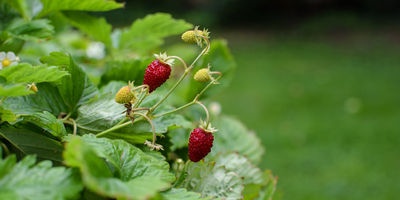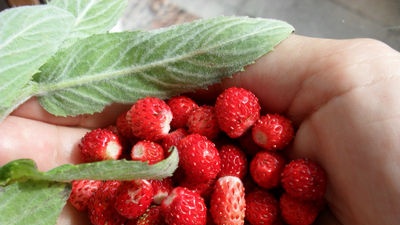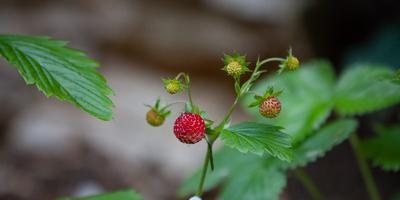|
 Experimental data with strawberries (Scotland) show that the number of flower buds formed in mid-August increases after harvesting (defoliation) of leaves. Experimental data with strawberries (Scotland) show that the number of flower buds formed in mid-August increases after harvesting (defoliation) of leaves.
In the experiments, strawberry plants were placed at a distance of 45.7 cm in a row, and 91.3 cm between rows. All whiskers were removed during processing.
The leaves were removed after the first, second and third years of fruiting. They were cut off with a scythe or scissors, leaving young newly developing leaves and removed along with the remains of straw. On the control plots, the usual post-harvest processing with the removal of whiskers and cleaning of straw from the row spacing. The strawberry plantations were kept in good condition.
We studied in more detail the varieties Redgoutlet, Talisman and Auchinkruiv Claymex.
Weighed healthy berries - commercial and damaged (by birds affected by mildew and gray rot) - not commercial.
Defoliation in August (beginning and middle) significantly increased, with the exception of one case, the number of flower buds and the yield for the next year, and the yield of marketable berries was sometimes 1–5 times higher than in the control. With a delay in defoliation until mid-September, the yield decreased slightly.
Yields of varieties Talisman and Redgoutlet corresponded to the number of flower buds; it mainly determines the yield per plant. Defoliation increased the appearance of peduncle rudiments in the Talisman variety by 70%, Redgoutlet - 50%.
Additional formation of peduncle rudiments occurs mainly a few weeks after defoliation, probably in early October.
The increase in yield from defoliation can be significant in years when plants do not form flower buds well and they have many sterile branches.
In any plantation where the main factor of low yields is insufficient formation of flower buds, defoliation is simple, relatively cheap and obviously harmless. This valuable technique is used on every strong growing, mature plantation of the studied varieties in Scotland. It is not recommended to remove leaves from young plantations in the year of planting. Apparently, it is rash to recommend defoliation on an insufficiently strong plantation, where the number of flower buds is not in short supply.
 After mowing the leaves on August 10 and 12, the increase in the yield of the Huxley variety was 20-25%. A slightly larger yield was obtained after burning the leaves, if the fire did not scorch the plants. The resulting increases in strawberry yield in different climatic conditions lead to the idea that defoliation can be successfully applied throughout the country of Scotland, although the best timing for its implementation is not the same. After mowing the leaves on August 10 and 12, the increase in the yield of the Huxley variety was 20-25%. A slightly larger yield was obtained after burning the leaves, if the fire did not scorch the plants. The resulting increases in strawberry yield in different climatic conditions lead to the idea that defoliation can be successfully applied throughout the country of Scotland, although the best timing for its implementation is not the same.
The experimental results are confirmed by data on vegetative growth under controlled conditions.
Various experiments (Guttridge, Thompson and Guttridge) have provided evidence that day length influences flowering; regulation of the formation of hormones in the leaves promotes vegetative growth while suppressing the formation of flowers. This indicates that the formation of peduncle buds is suppressed during long days by high hormone levels; this does not happen with a short day, when there is no damaging concentration of them. This means that the removal of leaves in August, that is, the removal of sources of suppression of flowers, should promote the formation of flower buds. However, after defoliation, new leaves quickly appear and unfold; at relatively long day lengths, they can form a sufficient amount of inhibitors (retarders) in order to delay the drop in their concentration at the point of growth to such a low level at which the budding of flowers can occur.This can explain the not always quick setting of flowers after defoliation.
According to Thompson and Guttridge, older mature leaves are more inhibitory than younger ones. Even with a seasonal decrease in inhibitor concentration in all plants with decreasing day length, the absence of old leaves on defoliated plants during the fall should give them an advantage over untouched plants.
From a practical point of view, the first half of August is the best time for defoliation of the leaves of the Talisman and Redgoutlet varieties in Scotland. For other varieties, this period may vary.
Removing leaves in August (shortly after harvest) sometimes significantly increased the yield of the Talisman and Redgoutlet varieties.
The yield increase was inversely proportional to the yield of control plants and ranged from 10%, when each plant in the control gave almost 908 grams of berries, to 400% - with a low yield in the control.
Fio
|
 Experimental data with strawberries (Scotland) show that the number of flower buds formed in mid-August increases after harvesting (defoliation) of leaves.
Experimental data with strawberries (Scotland) show that the number of flower buds formed in mid-August increases after harvesting (defoliation) of leaves. After mowing the leaves on August 10 and 12, the increase in the yield of the Huxley variety was 20-25%. A slightly larger yield was obtained after burning the leaves, if the fire did not scorch the plants. The resulting increases in strawberry yield in different climatic conditions lead to the idea that defoliation can be successfully applied throughout the country of Scotland, although the best timing for its implementation is not the same.
After mowing the leaves on August 10 and 12, the increase in the yield of the Huxley variety was 20-25%. A slightly larger yield was obtained after burning the leaves, if the fire did not scorch the plants. The resulting increases in strawberry yield in different climatic conditions lead to the idea that defoliation can be successfully applied throughout the country of Scotland, although the best timing for its implementation is not the same.








